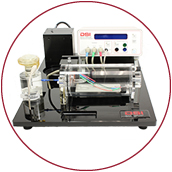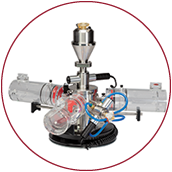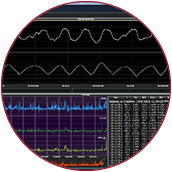September is Pulmonary Fibrosis Awareness Month. Each year, approximately 30,000 – 40,000 new cases are diagnosed in which patients suffer damage to lung tissues and disruption in lung function.1,2 The cause of damage is often never determined. However, it can occur when patients experience chronic exposure to specific toxins, medical conditions, drugs, or radiation treatments.2 Unfortunately, there is currently no way to repair tissue damage. Available therapies simply manage symptoms and some cases may require a lung transplant.2
Research to better understand pulmonary fibrosis is ongoing. In preclinical models, DSI’s Buxco® line of respiratory and inhalation solutions are often used to develop animal models, explore the disease’s effects on lung function, and evaluate treatment options.

Recent Publications
Cthrc1 lowers pulmonary collagen associated with bleomycin‐induced fibrosis and protects lung function
This study aimed to understand whether Collagen Triple Helix Repeat-Containing-1 (Cthrc1) protein could reduce collagen accumulation and damage to lung function. As bleomycin is known to induce pulmonary fibrosis, they administered either bleomycin or saline through intratracheal injections to Cthrc1 knockout and wild type mice. The scientists used DSI’s Buxco® Whole Body Plethysmography to measure breathing parameters 14 days later. The mouse lungs were harvested and the team also assessed bronchoalveolar lavage, hydroxyproline and lung compliance.3
Results of the study indicated Cthrc1 limits formation of fibrotic tissue and collagen accumulation, revealing its protective role.3 The team believes this assessment could aid in creation of new pulmonary fibrosis therapies.
Upregulation of RGS2: a new mechanism for pirfenidone amelioration of pulmonary fibrosis
As the FDA approved pulmonary fibrosis drug pirfenidone causes severe side effects at the required high dose level, it’s often not administered at full strength, reducing its effectiveness.4 This team of researchers wanted to better understand how pirfenidone works and improve its safety and efficacy.
To develop a mouse model of pulmonary fibrosis, the team administered bleomycin.4 A week later, the mice were dosed with pirfenidone using DSI’s inhalation tower. The team then assessed the dynamic lung compliance of the mice with DSI’s Buxco® resistance and compliance system.
The study showed pirfenidone’s expression of Regulator of G-protein Signaling 2 (RGS2) is key in its anti-fibrotic effects.4 This knowledge builds understanding of pulmonary fibrosis and may help identify safer and more effective therapies in the future.
Bleomycin Aggravates Atopic Dermatitis via Lung Inflammation in 2,4-Dinitrochlorobenzene-Induced NC/Nga Mice
The existence of a relationship between skin and lung inflammation related to allergic diseases is known. This study aimed to develop an effective animal model and better understand it. Specifically, the team wanted to know if injury to the lung would worsen atopic dermatitis (skin inflammation). To develop their mouse model, they administered an allergen (2,4-dinitrochlorobenzene) to cause atopic dermatitis and bleomycin to induce pulmonary fibrosis.
The team used DSI’s Buxco® Whole Body Plethysmography to measure airway hyperresponsiveness to study the impact of bleomycin on the lungs. In addition, the researchers evaluated skin lesions using a Clinical Skin Severity Score.
This study produced an effective animal model for further study of the pathogenesis and progression of allergic atopic diseases.5 It also showed that when bleomycin is combined with dinitrochlorobenzene, atopic dermatitis is more significant than 2,4-dinitrochlorobenzene alone and stimulates airway hyperactivity and lung inflammation.5
DSI Solutions
Including those mentioned in the publications above, DSI provides several types of respiratory measurement systems to assist pulmonary fibrosis researchers in a variety of applications.
Whole Body Plethysmography (WBP)
When conscious, unrestrained approaches are desired, the FinePointe WBP system allows researchers to measure respiratory endpoints. This approach is often used as a quick, easy way to screen compounds, run longitudinal studies, and assess the need for further research in a more invasive model.

Resistance and Compliance (RC)
The FinePointe resistance and compliance system assists researchers in measuring an animal’s airflow and lung pressure. A decrease in compliance, as a result of stiff lungs, is characteristic of pulmonary fibrosis.

Inhalation and Exposure
The Buxco® Inhalation and Exposure system allows researchers to expose animals to a compound in a controlled setting. The inhalation tower’s design ensures all subjects receive identical exposure amount. The tower uses a concentric design to evenly distribute compound and eliminate rebreathing. The Allay restraint positions each animal in the same way, while minimizing stress.

Pulmonary Function Test (PFT)
The PFT system allows for a comprehensive assessment of the lungs. All lung volumes and spirometry equivalent test results are completed in a matter of minutes; allowing for high throughput and quicker results.

FinePointe Software
FinePointe software is powerful and easy-to-use for collecting, analyzing, and reporting pulmonary life science data. Fully network-enabled, the smart design minimizes required user interaction while wizards walk users through necessary procedures.

To learn more about DSI’s solutions for pulmonary fibrosis research, visit our website and complete the form to connect with a representative.
References
1Baucom M. (2016). “IPF: Statistics, Facts, and You”. https://www.healthline.com/health/managing-idiopathic-pulmonary-fibrosis/ipf-facts#prevalence
2Mayo Clinic. (2018). “Pulmonary Fibrosis”. https://www.mayoclinic.org/diseases-conditions/pulmonary-fibrosis/symptoms-causes/syc-20353690
3Binks AP, Beyer M, Miller R, LeClair RJ. (2017). “Cthrc1 lowers pulmonary collagen associated withbleomycin-induced fibrosis and protects lung function”. Physiological Reports. 5 (5), 2017, e13115, doi: 10.14814/phy2.13115. https://physoc.onlinelibrary.wiley.com/doi/epdf/10.14814/phy2.13115
4Xie Y, Jiang H, Zhang Q, Mehrotra S, Abel PW, Toews ML, Wolff DW, Rennard S, Panettieri Jr. RA, Casale TB, Tu Y. (2016). “Upregulation of RGS2: a new mechanism for pirfenidone amelioration of pulmonary fibrosis”. Respiratory Research.
https://respiratory-research.biomedcentral.com/articles/10.1186/s12931-016-0418-4
5Sung Y-Y, Kim S-H, Yang W-K, Park Y-C, Kim HK. (2018). “Bleomycin Aggravates Atopic Dermatitis via Lung Inflammation in 2,4-Dinitrochlorobenzene-Induced NC/Nga Mice”. Frontiers in Pharmacology. 9:578. doi:10.3389/fphar.2018.00578. https://www.ncbi.nlm.nih.gov/pmc/articles/PMC5992277/